Tuk Tuks, Fletes and Chicken Buses is my Guatemalan version of Planes, Trains, and Automobiles, except I don’t wake up next to Aaron Lehman, my bunk mate, mistaking his butt for a pillow. Aaron and I have shared many adventures over the last 3 weeks, and there is no bond quite like that of a bunk mate in a dorm setting, but every adventure has its limits.
Our story begins with the sturdy 15 passenger Dodge Ram (circa 1970?) that we have been driving around in, and which we believed could easily survive a direct missile attack: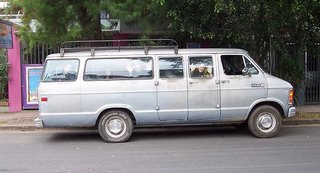
In retrospect, our confidence in the Dodge was based more on the weakness of other available vehicles than in the inherent strength of the Dodge. A group from George Fox University was here at Semilla the same time we were, and they were given use of a newer and more comfortable KIA van. However, on one of their out-of-town trips, it broke down and they had to take public buses back. They then rented a van for their next out-of-town trip, to ensure there wouldn’t be problems. That one caught fire while they were driving.
We were especially gleeful about all this, since deep down we resented that they got to zip around town in the nice van while we had to trudge along in the crappy Dodge. Thus, it seemed right for them to have van troubles. Regardless of our economic situations in our real lives, here in Guatemala they were the rich privileged kids with the shiny new uniforms and we were the ragtag group of poor kids with broken-down equipment and a drunken coach who learns to appreciate life again after he dates one of our moms. We may have had initial misgivings about our Dodge Ram, but after a few non-catastrophic outings (compared to the KIA), we learned to respect it, and eventually reached the point where we boasted of its feats of strength and endurance to any and all that would listen.
Here’s a picture of that same Dodge on the side of the road during our two day trip to Lake Atitlan, where it decided to stop running a number of times: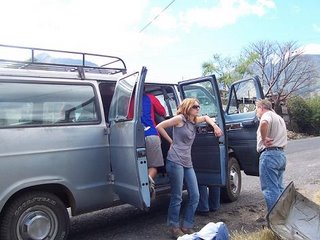
This presented a number of obvious problems for us. First, we were somewhere in Guatemala without transportation. Second, we were no longer the scrappy poor kids who won despite their hard-luck; we were now just the poor kids who got beat up with nothing to show for it. Third, we had come to believe that our fearless guide Carina (picture above) had mystical powers that protected us from any unfortunate events that might befall us, and we started to doubt her protective powers. Mostly though, we were somewhere in Guatemala without transportation.
But we had with us two first rate mechanics, Hugo, the Semilla handyman, and Saulo Padilla, our fellow student, and Guatemalan Christ-Figure (he grew up here and Knows All). We knew that if it was possible to get the van running, they would be able to accomplish it.
However, after messing with the engine (which is apparently in the dashboard) for a half hour or so, Carina took charge by fetching alternative transportation to the next town for lunch. Alternate transportation in this case was a “Flete”, which is basically a Toyota pickup truck with bars in the back so that people can stand up and go from one town to another, as long as the town isn’t very far. I don’t have a good picture of one from the outside, because, as in this picture, they are usually flying by at high rates of speed.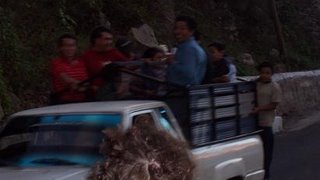
So, we all piled into one. “There is no such thing as ‘not enough room’ in Guatemala” says Carina. Here’s our ride, which was only about 10 minutes to the next town. I didn’t check, but I’m pretty sure there were not 18 functioning airbags in the back of the pickup. However, it was quite pleasant, like riding in a convertible with the top down, along with 18 of your closest friends.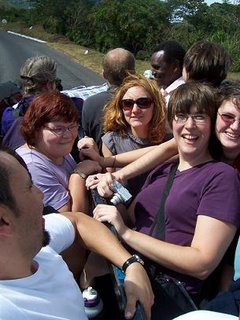
While stopped for lunch, we were surprised to see none other than our Dodge Ram resurrected from the dead, rolling into town: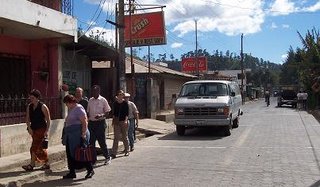
Hugo had gotten it started again. He claimed the problem was “muchos Gringos” (too many gringos). We acceded that this indeed could very well have been the problem, but we weren’t sure whether he was referring to us or the van (Dodge is of course the second most gringo make of vehicle, behind Chevy). However, we nonetheless piled in after lunch, without attempting to solve either of our Gringo problems. Predictably, the van rolled to its final resting space for the day about 15 minutes later: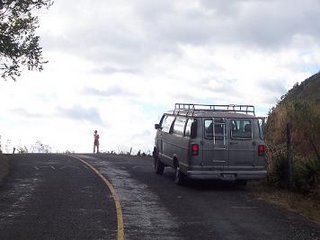
We were only a few hundred feet from the top of the hill and we considered pushing it up the rest of the way, so we could coast downhill all the way to our destination of Santiago. We even had a miniature Jessica Uhl available for directing traffic (seen standing at the top of the hill). Luckily, the normal sized Jessica keeps a mini-her in her enormous backpack for occasions just like this.
Instead, we did what any group would do in this situation – we sent Kent Yoder (not pictured) up the very steep hill (not pictured) on the left to look for the source of the avocados that were sprinkled alongside the road. Like Lewis and Clark before him, he found neither a Northwest Passage nor any avocado trees, but he did manage to tumble out of the brush onto the road and sprain his ankle (not pictured). Meanwhile, Hugo and Saulo once again tried valiantly to get the van started, but this time the gringo overload could not be overcome.
But, we were saved once again by Guatemala’s surprisingly robust public transportation system. This time it was a Chicken Bus that came by (stock photo below):
A Chicken Bus is the greyhound of Guatemala, except one seems to pass by every 20 minutes instead of every 20 hours. They are called Chicken Buses because you can carry just about anything on them, including live chickens (although they are usually in crates on the top). Normally Chicken Buses are overflowing with people and things and animals, but ours was pretty comfy as there weren’t a lot of people on it, so we loaded up our considerable collection of luggage and breezed through the rest of the trip into Santiago.
Since we no longer had transportation once we got into Santiago, we needed a way to get to our hotel, which was outside city limits. Actually, it wasn’t a hotel; it was some kind of church camp with no drinking water or hot water for showers. But I digress. After a very nice meal, we hung around the town square to get alternate transportation. We still had all our luggage with us, which in this case included pillows and blankets because our hotel/church camp didn’t provide them. A good lesson learned here is that when you are hanging out in a town square in a very machismo culture, there is nothing more emasculating than holding your blankie and pillow like you are going to a sleepover (not pictured).
The alternative form of transportation turned out to be a “Tuk Tuk”, pronounced Tuke Tuke, which I misprounced a number of times in various ways before getting it down. A Tuk Tuk is basically a golf cart, but driven by a crazed Latino. It was by far the most fun way we have travelled so far. Here is what they look like when you are a pedestrian and they are bearing down on you, giving you the choice to either become a customer or risk what seems like imminent death: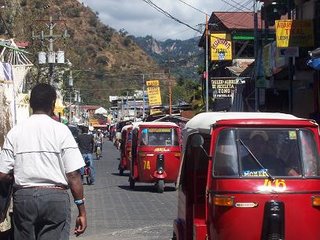
We needed five Tuk Tuks, since they seat at most 3 people. Samantha Loia, Moriah Hurst and I piled into one. We are three pretty average-sized people, but it was a pretty tight squeeze. I’m pretty sure that if our Tuk Tuk had been hit by a Chicken Bus and we rolled down the side of the mountain, we would have still been wedged into that seat when they found us. Another interesting fact about Tuk Tuks is that if you cheer on the driver, he will pass the other slowerTuk Tuks in your party, and restore a small measure of the manhood you lost when holding tightly to your pillow in a public square.
While we were having fun with the Tuk Tuks, Hugo and Saulo were trying to rescue the Dodge Van. I don’t have pictures since I wasn’t there, but on the first attempt, the retrieval vehicle overheated. Then it ran out of gas. Lastly, it got a flat tire. The ancient Mayan traveling gods were indeed angry at Mennonites that day. Hugo and Saulo didn’t get the van into town until well after midnight and spent the night in a (real) hotel. Presumably, their only consolation for this Herculean effort was hot water for their showers.
By the next morning, the ever resourceful Carina, whose descent into ordinariness was quite brief, had again magically secured alternative transportation. We had two 12 person vans, which felt embarrassingly luxurious to us (we do remain Mennonite, after all). Here’s our van: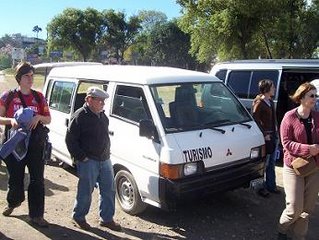
The only problem with the van was the “Tourist” sign plastered on the front. As if it were not already glaringly obvious that we were largely comprised of pasty faced gringos, we had a sign that pre-announced us as culturally insensitive and ready to exploit and/or be exploited. Nonetheless, we were glad to finally have reliable transportation.
After touring Santiago’s mudslide area and peace park, we planned to cross Lake Atitlan in rented boats to the town of Panachajelsomethingorother, which is a tourist shopping mecca. We were travel-hardened by then, and a boat ride across a lake seemed like recreation at this point. We took two boats, one of which was called “El Quetzel”, after either the national bird, or the national currency (which is named after the bird). They were basically little cigar boats, and we expected a nice, leisurely crossing of the lake: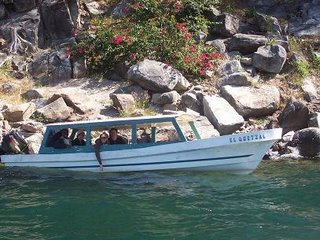
We didn’t sink, if that is what you might be expecting at this point. However, it was a very windy day. The wind produced pretty good-sized waves. The boats got thrown around a little. We took some videos:
As Gayle Gerber-Koontz pointed out, every time Jessica and Alissa screamed from the front of the boat, it was a good warning to lift up your body a little to save your lower back from the imminent high impact crash on the seat of the boat. Gayle bumped her head a few times on the top of the boat this way, but it seemed worth it.
Here’s a picture of the other boat in the water. I tried to get a picture of the 75 degree angle it seemed to achieve every now and then, but wasn’t able to capture it. Maybe it was my imagination, or the blows to the body I was receiving during the ride.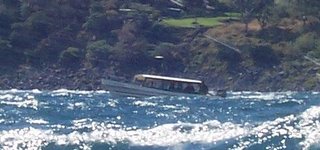
We made it there just fine though, without too many body bruises. We gave in to our tourist impulses, did some shopping and then left for “home” (Guatemala City) in our rented vans. The trip home was merely a boring four hour trip where we encountered no calamities except bad traffic. The rented vans couldn’t even manage to bump into each other, much less crash into anything grand and spectacular.
So, for those counting at home, that’s six official modes of transportation for the originally planned 3 hour trip to Lake Atitlan: Dodge Ram, Flete, Chicken Bus, Tuk Tuk, Tourist Mobile, and Cigar Boat. Kent Yoder, of bruised ankle fame, was able to score a seventh mode, due to his sore ankle: Travel by Shoulder. Overall, Kent was kind enough to physically embody the trip for us, as he limped from place to place without too much complaining.
I hope none of my jokes about this trip indicate that I was unhappy about it. Even with a dicey digestive system at the time, I wouldn’t change anything about this particular trip. Only by having massive problems were we able to have the experience of touring the Guatemalan public intercity transportation system, which in hindsight, is actually better than in the US. If your van breaks down in the US, there are no Fletes or Chicken Buses to come pick you up for a few dollars to the next town. Also, Santiago was a great town to be in - lots of great character and it doesn’t seem to suffer from tourististia too much. I plan to leave my pillow at home though for the next trip.
If this story were to have a moral, it would be this: Having large numbers of people who can’t afford their own transportation works to the advantage of those who do have sketchy, unreliable transportation.
UPDATE 1/24/07: We are back home now, and on the way home from the airport we rode in the 15 passenger van here at AMBS. It seemed cramped on the way to the airport at the beginning of the trip. Last night, it seemed like an unnecessary luxury. Three weeks can certainly change's one perspective.
Monday, January 22, 2007
Tuk Tuks, Fletes and Chicken Buses
Subscribe to:
Post Comments (Atom)

4 comments:
"...were no longer the scrappy poor kids who..."
"...they were the rich privileged kids with the shiny new uniforms and we were the ragtag group of poor kids with..."
It finally struck me. Reading these analogies and others like them in your blog, I realized where they come from. To wit:
You once said to me that kids who grew up in the country could survive in the wilderness, kids who grew up in the city could survive in that jungle, but kids who grew up in the suburbs could only survive in shopping malls. Are these analogies a product of that frame of mind? I think they must be.
Funny? Absolutely, but not really true is it? I mean, you're doing okay. Even the products of suburbia have hope of surviving in the "third world" (I don't care for the term, but can't think of another off hand).
Peace.
I had completely forgotten saying anything like that, but will gladly reclaim it.
It would be more true if it were "preparation" rather than "survival". But I like the original overstatement better.
This is the funniest blog post I've read in a long time. Every other paragraph had me laughing out loud. What a great story, especially since I know most of the main characters. Thanks much for sharing this! It brings back memories of my own time at CASAS many years ago.
Oh dear! And here's me thinking that you were making references to the Mighty Ducks (or I suppose any other beating-the-odds Disney sports movie). I like your clever blog.
Post a Comment